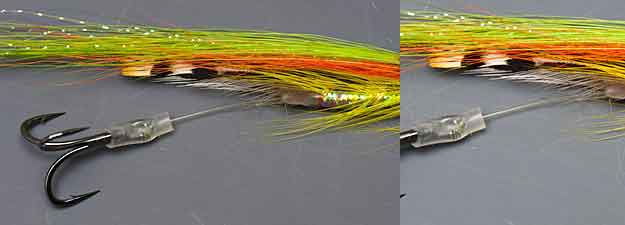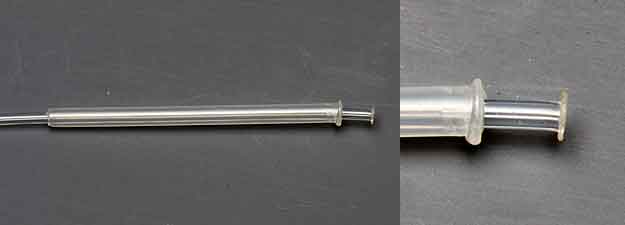- HOME
- KEN SAWADA COLUMN
- TACTICS
- Semi-Free Hook System with Micro Tube
KEN SAWADA'S FLY FISHING TACTICS
Semi-Free Hook System with Micro Tube

Different methods were invented because of various fishing aims. Various aims sounds strange but I mean what is the most important is different between anglers.
Every method has both strong and weak points. There is no point of discussing the best one.

In the light of good hooking performance, one of the most important aims, it would be quite sure that free hook system make a great achievement beyond compare. In usual conditions, since water resistance pushes the fly against the hook, fish’s catching the fly is equal to its catching the hook.
But what will happen, if the hook is off the fly when the fish has caught the fly?
Anglers will not get proper hooking because the fish has caught the fly but not the hook. Even if they manage to get hooking, the hook will easily come off when strong power is put on the hook because the hooking way or hooking spot is not good.

The hook came off the fly when I cast the fly downstream. It never happens in usual conditions but frequently happened in the River Gaula in 2010. It was because flooding in the previous autumn there formed many points where the river was flowing in a strange way at the lower reaches. Sharp reversal currents, whirlpools, downward streams and upward streams were mixed in a pool. Therefore, not only the fly but also the line and the leader moved in an unexpected way.
All of hooking troubles happened at those spots. Even knowing how those troubles happened, we can not give up those spots full of fish. Then I tried to invent a new method.

It is what I call semi-free hook system.
Before introducing this new system, let me explain a little about why this system is necessary and when it is efficient.
First of all, I check an ordinary free hook system with silicone tube. (See Free Hook Method)
Then I check another free hook system with mini plastic tube. (See Free Hook with Mini Plastic Tube)
Now my new semi-free hook system is based on the same idea of that using mini plastic tube. My old method has a free hook system because of a short plastic tube which covers the hook.
Now I want to get a semi-free hook, a little bit close to a fixed hook. Here a magnum silicon tube covers the hook and a new micro plastic tube, instead of a mini plastic tube, is inserted in the magnum silicon tube.

ロングプラスティックチューブ Micro
Features of Semi-Free Hook System
1) Putting a micro plastic tube into a magnum silicone tube increases frictional resistance and enables the hook to hardly come off in the water. However, the hook easily comes off at hooking because only a length of 2mm of the micro plastic tube is inserted.I call it semi-free hook system because the hook easily comes off to be free.

2) Different from the ordinary method with flex silicone tube, in this method a silicone tube does not need to cover the rear end of the fly body. We can insert a micro plastic tube into the finished fly. (Insert it from the fly head.) That means it is easy to change our flies into this system from now on.

A micro plastic tube is inserted tightly into a small plastic tube. Add a drop of glue to fix two tubes. If it is inserted into a standard plastic tube, wind a short length of thread around it, which prevents it from easily coming off.

3) How easily or not so easily the hook comes off can be arranged by changing the length, ---making 1 or 2mm longer or shorter--- of a magnum silicone tube which covers the hook and a micro plastic tube which sticks out from the rear end of the fly body.
4) If the fly is dressed directly on a micro plastic tube, a mini silicone tube should cover the hook and it will also have semi-free hook system.
Working Process
1) Melt the tip of a plastic tube a little, which forms a body, over a flame of the lighter and push it against a piece of glass immediately to make the moulded end. This procedure prevents the thread from slipping during fly dressing. The photo shows a small plastic tube.
2) Set the tip of a micro plastic tube, the inner part, over a flame of the lighter and do the same as the above. After dressing the fly, insert the micro plastic tube into the body tube. Insert it from the fly head. Add a drop of the glue between two tubes to fix them.

3) Cut the micro plastic tube so that 2mm of it sticks out of the rear end of the body tube.

4) To set a hook, pass the leader through the body tube and a shortly-cut magnum silicone tube. Then put the leader to the hook. The hook here is ST4 #5.

5) Insert the hook into the magnum silicone tube so that a length of 2mm of the leader from the knot is also in that tube.

6) Hold the fly and pull the leader until the silicone tube covers the micro plastic tube. That is all.

7) If the fly is dressed directly on the micro plastic tube, insert the hook into a mini silicone tube in the same way. The hook here is XD1 #10.


[Translated into English by Miyoko Ohtake]
- TROPHY CLUB
- FLY SHOW
- EXHIBITION
- MASTERS`
- FLY DRESSING CONTEST Archives
- TRAVELLER Archives
- TACKLE IMPRESSIONS Archives
- ANGLERS` PHOTO GALLERY Archives
- ----------------------------------------------
- トロフィークラブ
- フライショー
- エキシビション
- マスターズ
- フライドレッシング・コンテスト・アーカイヴ
- トラヴェラー・アーカイヴ
- タックル・インプレッション・アーカイヴ
- アングラーズ・フォトギャラリー・アーカイヴ
株式会社サワダ 185-0021 東京都国分寺市南町3-13-4
SAWADA'S INC. 3-13-4 Minamicho, Kokubunji, Tokyo 185-0021, Japan
写真・ドキュメントの無断転載を禁じます。
All the images and documents found on this site are owned by Ken Sawada and may not be used without permission.
But, link to this site is FREE.
Copyright © 2000 - 2025 SAWADA'S INC.. All rights reserved.
SAWADA'S INC. 3-13-4 Minamicho, Kokubunji, Tokyo 185-0021, Japan
写真・ドキュメントの無断転載を禁じます。
All the images and documents found on this site are owned by Ken Sawada and may not be used without permission.
But, link to this site is FREE.
Copyright © 2000 - 2025 SAWADA'S INC.. All rights reserved.